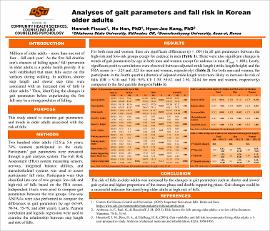| dc.contributor.advisor | Han, Ho | |
| dc.contributor.author | Fiscus, Hannah | |
| dc.contributor.author | Kang, Hyun-Joo | |
| dc.date.accessioned | 2023-04-11T14:30:01Z | |
| dc.date.available | 2023-04-11T14:30:01Z | |
| dc.date.issued | 2023-04-18 | |
| dc.identifier | oksd_URS_2023_fiscus | |
| dc.identifier.citation | Fiscus, H., Kang, H., & Han, H. (2023, April 18). Analyses of gait parameters and fall risk in Korean older adults. Poster session presented at the Oklahoma State University Undergraduate Research Symposium, Stillwater, OK. | |
| dc.identifier.uri | https://hdl.handle.net/11244/337348 | |
| dc.description.abstract | More than one in four older adults fall each year. As the first fall doubles one’s chances of falling again, fall prevention in older adults is a public health priority. Since it is well-established that most falls occur on flat surfaces during walking, identifying the changes in gait parameters before one’s first fall may be a strong predictor of falling. | |
| dc.description.abstract | PURPOSE: To examine gait parameters in older adults associated with the risk of falls. | |
| dc.description.abstract | METHODS: 200 older adults (72.8 ± 5.6 years; 74% women) participated in the study. Participants’ gait parameters were measured through a gait analysis system. The Fall Risk Assessment (FRA) system measured sensory, nervous, integrated balance abilities, and musculoskeletal systems to assess fall risks. Participants were classified into one of two groups: low- and high-risk of falls based on the FRA scores. Independent t-tests were used to compare the gait parameters between the two groups. One-way ANOVAs were performed to compare the differences in gait parameters by age (65-69, 70-74, 75-79, and ≥80 years). Lastly, Pearson correlation and logistic regression were used to examine variables in step length and fall risk. | |
| dc.description.abstract | RESULTS: For both men and women, there were significant differences (p < .001) in all gait parameters between the two groups except for cadence in men. There were also significant changes in trends of gait parameters by age in both men and women except for cadence in men (Ptrend <.001). Lastly, significant positive correlations were observed between adjusted stride length (stride length/height) and the FRA scores (r=.524 and .323 for men and women, respectively). For both men and women, the participants in the fourth quartile (shorter) of adjusted stride length were more likely to increase one’s fall risk (OR = 9.10 and 7.88; 95% CI: 1.39, 59.62 and 2.50, 24.84 for men and women, respectively) compared to the first quartile (longer). | |
| dc.description.abstract | CONCLUSION: The risk of falls was increased by changes in gait parameters such as shorter and slower gait cycles and higher proportions of the stance phase and double supporting phase. Gait changes could be a successful indicator for identifying high-risk of falls in older adults. | |
| dc.format | application/pdf | |
| dc.language | en_US | |
| dc.publisher | Oklahoma State University | |
| dc.rights | In the Oklahoma State University Library's institutional repository this paper is made available through the open access principles and the terms of agreement/consent between the author(s) and the publisher. The permission policy on the use, reproduction or distribution of the article falls under fair use for educational, scholarship, and research purposes. Contact Digital Resources and Discovery Services at lib-dls@okstate.edu or 405-744-9161 for further information. | |
| dc.title | Analyses of gait parameters and fall risk in Korean older adults | |
| osu.filename | oksd_URS_2023_fiscus.pdf | |
| dc.description.department | Community Health Sciences, Counseling and Counseling Psychology | |
| dc.type.genre | Poster | |
| dc.type.material | Text | |
| dc.type.material | Image | |
| dc.subject.keywords | gait | |
| dc.subject.keywords | fall risk | |
| dc.subject.keywords | elderly | |
| dc.subject.keywords | walking patterns | |
